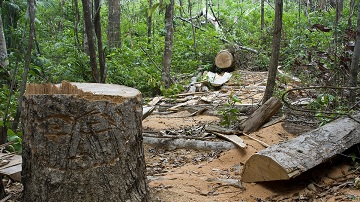Why Norway Is Paying A South American Country To Not Cut Down Its Trees
 As part of a landmark deal, the Scandinavian country is investing in deforestation-prevention efforts in Guyana, in the hopes that it might help slow climate change around the world.
As part of a landmark deal, the Scandinavian country is investing in deforestation-prevention efforts in Guyana, in the hopes that it might help slow climate change around the world.It’s an odd arrangement at first glance: Norway is sinking hundreds of millions of dollars into Guyana, in the hopes that the latter country will slow deforestation and subsequently help stall climate change. It’s a recognition that climate change is a global problem that can’t be solved by any one country: What happens in Guyana will affect Norway, so Norway might as well invest in climate solutions around the world. It’s a partnership that just might work–or, as with so many other climate initiatives, it could fail spectacularly.
Bharrat Jagdeo, the president of Guyana from 1999 to 2011, never thought much about deforestation and its links to climate change. Then the floods came. In 2006, the country saw the worst flooding in its history; they wiped out the equivalent of 60% of Guyana’s GDP. With over half of the country below sea level, suddenly climate change seemed like more of a pressing problem. And when the Intergovernmental Panel on Climate Change released a report estimating that deforestation is responsible for a fifth of all carbon emissions, Jagdeo realized that Guyana had something to offer: Over 80% of the country is still covered in forests.
In 2008, Guyana began discussions with the U.K. about teaming up–the U.K. would pay for Guyana to stop deforestation. “Tony Blair loved the idea. He said, we’ve got lots of resources but no forests, you have forests but no resources, why don’t we get together? Guyana was a laboratory for seeing what the world could do to fix this problem, but big enough to be relevant,” explains Kevin Hogan, a presidential advisor to Jagdeo. The U.K. deal fell through, but not before it caught the attention of the prime minister of Norway.
The next year, Guyana and Norway reached a deal: Norway would pay up to $250 million through 2015 for Guyana to cut down on greenhouse gas emissions from deforestation. That year was chosen because the two countries assumed that the international REDD (Reduced Emissions from Deforestation and Degradation) program would be up and running by then. That’s not going to happen anytime soon; nonetheless, the deal seems to tentatively be working.
It wasn’t an easy decision for Guyana to agree to a partnership. “Our experience with aid and the developing world experience has not been a good one,” says Jagdeo. “Pledges achieve many goals but we’ve found delivery and dispersement of resources have [problems]. Then we had to convince people. There’s this national mindset of ‘Why are you going to pledge this valuable asset to the world when we have poverty, we have people who depend on these assets, and they may pledge aid that may never come?’”
So far, Jagdeo is cautiously pleased with the deal. Guyana has received a total of $115 million, which is now going towards strengthening the country’s infrastructure. The country is laying down fiber optic cables, for example, to boost ICT-enabled employment. Some of the money is going towards a hydroelectric project expected to save businesses and residents $3.5 billion over 20 years due to a decreased dependence on foreign energy.
According to an independent verification audit from Det Norske Veritas, Guyana had a deforestation rate of 0.054% between October 1, 2010 and December 31, 2011. That’s one of the lowest deforestation rates in the world. Nonetheless, there is a lot of room for improvement. A separate audit in 2012 from the Rainforest Alliance lists numerous problem areas, including protection of indigenous rights, the continuation of “transparent and effective multi-stakeholder consultations,” and transparent oversight of financial support (that last verification indicator was deemed to be “partially met”).
There are also lingering questions about what will happen in 2015 after Norway stops giving Guyana money (that is, if Norway doesn’t decide to just continue financing Guyana’s anti-deforestation efforts). Jagdeo is still hoping for a global climate agreement that can keep the Nordic country’s efforts going. “There’s a huge recognition that adaptation has to be funded but that REDD+ will be an important part of mitigation efforts and has to be funded. We are hoping that the mechanism will be in place by that time,” he says.
And if it isn’t? Says Jagdeo: “We hope that’s not the case because it would be a disaster for the world. I don’t want to think about it, but it could be an extension of the Norwegian agreement, it may be that enlightened countries may be willing to work with countries like ours in the developing world.”
There are a limited amount of developed countries who would want to be involved in a partnership like the one between Norway and Guyana, however. Jagdeo cites Germany as a country that might be game for it.
On the developing world side, there is no shortage of countries that want their own Norway-like arrangement. After traveling to 20 countries in the last year–including 16 in Africa–Jagdeo found that political leaders had “a desire to preserve the forest, a deep understanding … that they can and they have to preserve their forests.”
You can return to the main Market News page, or press the Back button on your browser.

